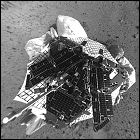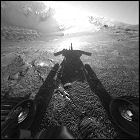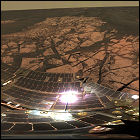 The first of two new American Mars rovers lands successfully on the red planet. The Mars rover Spirit enters the Martian atmosphere (and cleaves a path right through a dust storm), deploying thick layers of airbags that allow it to bounce safely until landing upright. This is the same landing system employed by the Pathfinder mission in 1997, but the unmanned robot probe in this case is much more sophisticated. Among the primary scientific objectives of Spirit’s mission is to determine if water existed on the surface of Mars for a significant length of time. The Spirit rover will undergo a series of diagnostics and won’t begin its mobile mission for several days. Its identical twin, a rover named Opportunity, will land in three weeks.
The first of two new American Mars rovers lands successfully on the red planet. The Mars rover Spirit enters the Martian atmosphere (and cleaves a path right through a dust storm), deploying thick layers of airbags that allow it to bounce safely until landing upright. This is the same landing system employed by the Pathfinder mission in 1997, but the unmanned robot probe in this case is much more sophisticated. Among the primary scientific objectives of Spirit’s mission is to determine if water existed on the surface of Mars for a significant length of time. The Spirit rover will undergo a series of diagnostics and won’t begin its mobile mission for several days. Its identical twin, a rover named Opportunity, will land in three weeks.

 The Opportunity rover, identical to Spirit, lands on schedule and on target in Mars’ Meridiani Planum region, but initial readings from the surface of Mars indicate that the landing pod containing Opportunity has come to rest on its side. Telemetry signals from Opportunity announce that the the rover has arrived safely and intact, ready to begin its mission, and the opening of the landing vehicle returns Opportunity to its intended upright position. As with Spirit, Opportunity will remain on its landing platform for several days undergoing a series of diagnostic tests before rolling off to the Martian surface for independent exploration, and engineers are keeping a close eye out for signs of a computer problem that has plagued Spirit for several days.
The Opportunity rover, identical to Spirit, lands on schedule and on target in Mars’ Meridiani Planum region, but initial readings from the surface of Mars indicate that the landing pod containing Opportunity has come to rest on its side. Telemetry signals from Opportunity announce that the the rover has arrived safely and intact, ready to begin its mission, and the opening of the landing vehicle returns Opportunity to its intended upright position. As with Spirit, Opportunity will remain on its landing platform for several days undergoing a series of diagnostic tests before rolling off to the Martian surface for independent exploration, and engineers are keeping a close eye out for signs of a computer problem that has plagued Spirit for several days. NASA scientists unveil new findings from the two Mars Exploration Rovers, Spirit and Opportunity. While both rovers have found evidence of water erosion in rocks at their respective landing sites, the scientists now say that Opportunity’s landing site – a large crater – features rocks which show conclusive evidence of a large body of salt water, not unlike Earth’s oceans. While no definitive signs of life have been found by Opportunity or its identical twin, these findings continue to add up to a picture of Mars as a place where life once could have thrived.
NASA scientists unveil new findings from the two Mars Exploration Rovers, Spirit and Opportunity. While both rovers have found evidence of water erosion in rocks at their respective landing sites, the scientists now say that Opportunity’s landing site – a large crater – features rocks which show conclusive evidence of a large body of salt water, not unlike Earth’s oceans. While no definitive signs of life have been found by Opportunity or its identical twin, these findings continue to add up to a picture of Mars as a place where life once could have thrived.  NASA announces that the Spirit rover has exceeded its mission goals of 90 continuous Martian days of operation since landing, with over 600 meters of the Martian surface covered. NASA applies for, and receives approval on, a plan to keep Spirit and Opportunity roving through September, almost tripling the rovers’ planned life span. The extended mission, made possible by a budget boost of $15 million, will give engineers the chance to try handing control over to the Rovers’ built-in systems, and it’ll afford a greater opportunity to examine the unusual rocks and evidence of past bodies of water on the Martian surface.
NASA announces that the Spirit rover has exceeded its mission goals of 90 continuous Martian days of operation since landing, with over 600 meters of the Martian surface covered. NASA applies for, and receives approval on, a plan to keep Spirit and Opportunity roving through September, almost tripling the rovers’ planned life span. The extended mission, made possible by a budget boost of $15 million, will give engineers the chance to try handing control over to the Rovers’ built-in systems, and it’ll afford a greater opportunity to examine the unusual rocks and evidence of past bodies of water on the Martian surface. Lakeshore Records releases
Lakeshore Records releases  NASA’s Spirit Mars rover becomes stuck in an area of soft, dusty soil in which its wheels can no longer gain traction. Efforts to simulate the problem on Earth begin, as well as studies to see if Spirit can free itself, but attempts to wiggle or rotate the rover’s wheels on Mars produce no results (and eventually wear out the independent motor of another of its wheels). The attempts to free Spirit from its Martian sandtrap continue through early 2010.
NASA’s Spirit Mars rover becomes stuck in an area of soft, dusty soil in which its wheels can no longer gain traction. Efforts to simulate the problem on Earth begin, as well as studies to see if Spirit can free itself, but attempts to wiggle or rotate the rover’s wheels on Mars produce no results (and eventually wear out the independent motor of another of its wheels). The attempts to free Spirit from its Martian sandtrap continue through early 2010.